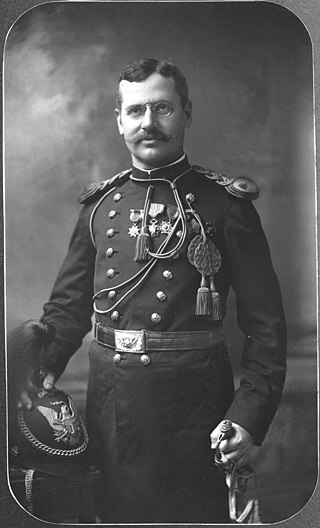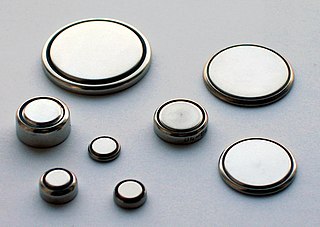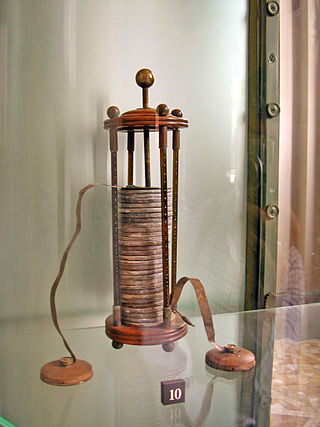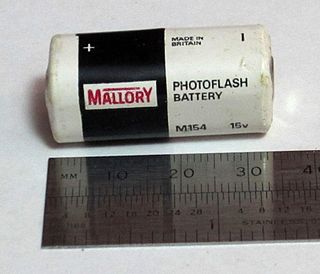Related Research Articles

Union Carbide Corporation is an American chemical corporation which is a wholly owned subsidiary of Dow Chemical Company. Union Carbide produces chemicals and polymers that undergo one or more further conversions by customers before reaching consumers. Some are high-volume commodities and others are specialty products meeting the needs of smaller markets. Markets served include paints and coatings, packaging, wire and cable, household products, personal care, pharmaceuticals, automotive, textiles, agriculture, and oil and gas. The company is a former component of the Dow Jones Industrial Average.
Eveready Battery Company, Inc. is an American manufacturer of electric battery brands Eveready and Energizer, owned by Energizer Holdings. Its headquarters are located in St. Louis, Missouri.

Energizer Holdings, Inc. is an American manufacturer and one of the world's largest manufacturers of batteries, headquartered in St. Louis, Missouri. It produces batteries under the Energizer, Ray-O-Vac, Varta, and Eveready brand names and formerly owned several personal care businesses until it separated that side of the business into a new company called Edgewell Personal Care in 2015.

Myron Timothy Herrick was an American banker, diplomat and Republican politician from Ohio. He served as the 42nd governor of Ohio and United States Ambassador to France on two occasions.

James Webb Cook Hayes was an American businessman and soldier. He co-founded a forerunner of Union Carbide, served in three wars, and received the Medal of Honor.

A dry cell is a type of electric battery, commonly used for portable electrical devices. Unlike wet cell batteries, which have a liquid electrolyte, dry cells use an electrolyte in the form of a paste, and are thus less susceptible to leakage.
Lewis Frederick Urry was a Canadian-American chemical engineer and inventor. He invented both the alkaline battery and lithium battery while working for the Eveready Battery company.

The AA battery is a standard size single cell cylindrical dry battery. The IEC 60086 system calls the size R6, and ANSI C18 calls it 15. It is named UM-3 by JIS of Japan. Historically, it is known as D14, U12 – later U7, or HP7 in official documentation in the United Kingdom, or a pen cell.

A zinc–carbon battery (or carbon zinc battery in U.S. English) is a dry cell primary battery that provides direct electric current from the electrochemical reaction between zinc (Zn) and manganese dioxide (MnO2) in the presence of an ammonium chloride (NH4Cl) electrolyte. It produces a voltage of about 1.5 volts between the zinc anode, which is typically constructed as a cylindrical container for the battery cell, and a carbon rod surrounded by a compound with a higher Standard electrode potential (positive polarity), known as the cathode, that collects the current from the manganese dioxide electrode. The name "zinc-carbon" is slightly misleading as it implies that carbon is acting as the oxidizing agent rather than the manganese dioxide.

The nine-volt battery, or 9-volt battery, is an electric battery that supplies a nominal voltage of 9 volts. Actual voltage measures 7.2 to 9.6 volts, depending on battery chemistry. Batteries of various sizes and capacities are manufactured; a very common size is known as PP3, introduced for early transistor radios. The PP3 has a rectangular prism shape with rounded edges and two polarized snap connectors on the top. This type is commonly used for many applications including household uses such as smoke and gas detectors, clocks, and toys.

VARTA AG is a German company manufacturing batteries for global automotive, industrial, and consumer markets.

Eveready Industries India Ltd. (EIIL) is an Indian company that manufactures and markets batteries and lighting products. The Eveready brand has been present in India since 1905. It also manufactures photogravure plates, castings, carbon electrodes and related products.

A button cell, watch battery, or coin battery is a small single-cell battery shaped as a squat cylinder typically 5 to 25 mm in diameter and 1 to 6 mm high — resembling a button. Stainless steel usually forms the bottom body and positive terminal of the cell; insulated from it, the metallic top cap forms the negative terminal.

Batteries provided the primary source of electricity before the development of electric generators and electrical grids around the end of the 19th century. Successive improvements in battery technology facilitated major electrical advances, from early scientific studies to the rise of telegraphs and telephones, eventually leading to portable computers, mobile phones, electric cars, and many other electrical devices.

P. R. Mallory and Co Inc was a US producer of dry cell batteries, electronic components including electrolytic capacitors, and audible warning devices ("Sonalert"). It also was the parent firm of Mallory Batteries Ltd., an Irish producer of Ever Ready batteries. British Ever Ready had a large stake in it by World War II and had a close relationship with Mallory by the late 1960s. In the US, "Eveready" batteries were a trademark of Union Carbide, which had no relationship with P. R. Mallory.
Spectrum Brands Holdings, Inc. is an American diversified company headquartered in Middleton, Wisconsin. It was established in 2005 as the successor to Rayovac Corporation. It is one of the Fortune 500 companies, and among the largest of its kind.

Washington Herbert Lawrence was a pioneer in the manufacture of electrical and carbon products who organized and served as the first president of the National Carbon Company, one of the founding members of the Union Carbide & Carbon Corporation.
GrafTech International Ltd. is a manufacturer of graphite electrodes and petroleum coke, which are essential for the production of electric arc furnace steel and other metals. The company is headquartered in Brooklyn Heights, Ohio and has manufacturing facilities in Calais, France, Pamplona, Spain, Monterrey, Mexico, and St. Marys, Pennsylvania.
The Boulton Carbon Company was a manufacturing company located in Cleveland, Ohio, US, from 1881 to 1886. It was devoted to the manufacture of carbon points used for arc lighting. The company was organized in 1881 by W. H. Boulton and Willis U. Masters and formally incorporated in 1883. A controlling interest in the company was acquired in 1886 by a group of investors led by Washington H. Lawrence. In 1886, Lawrence reorganized the Boulton Carbon Company as the National Carbon Company. Under the leadership of Lawrence, the National Carbon Company became the dominant carbon company in the United States and was one of the founding members of the Union Carbide & Carbon Company in 1917.
References
- ↑ Eveready Battery Company Records Collection at the Rutherford B. Hayes Presidential Center
- ↑ "Columbia Dry Cell Battery". National Historic Chemical Landmarks. American Chemical Society. Archived from the original on May 15, 2016. Retrieved June 7, 2012.
- ↑ Moody, John, The Truth about the Trusts: A Description and Analysis of the American Trust Movement, Moody Publishing Company, 1904 p. 261
- ↑ The Chicago Banker, Volume 1, Page 188.Chicago Banker Company 1899
- ↑ "Big Carbon Firms Combine: Three-fourths of this Industry in the World Included" New York Times, January 10, 1899
- ↑ Salvetti, Carlo (2001). "Fermi's Pile". In C. Bernardini and L. Bonolis (ed.). Enrico Fermi: His work and legacy. New York N. Y.: Springer Verlag. pp. 177–203. ISBN 3540221417.
- ↑ "National Carbon Company, Inc., letters of Leo Szilard". Library Digital Collections. University of California San Diego. Retrieved May 7, 2022.